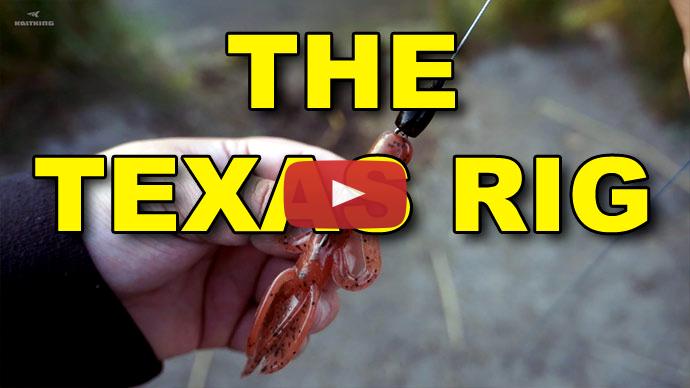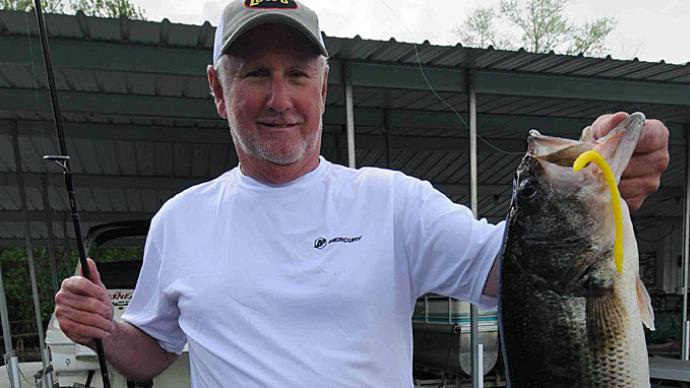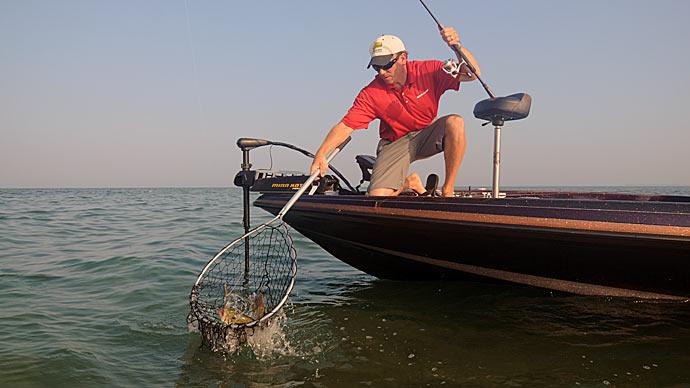Glenn: We have a customer. There we go. Oh, you're gonna want to go over on this side, okay? There we go. That floating worm is right in his face. Look at that right there. And he took that. You don't think these guys want it? I just... It's literally the very next cast. And that hook is in there. Wow. There we go. A little buck. Oh, hey. All right, let's let this boy go. Off you go.
Hey, folks, Glenn May here with BassResource.com, and today I want to talk to you about fishing floating worms, and I'm going to show you a way to do it that I've been doing it for many decades and, honestly, if you look on YouTube, I don't think I've seen anybody show you how to do it this way. If they have, I just haven't seen it. Or if you're watching this video a few years later and you see a lot of videos about how to do it this way, well, this is how they learned it.
So, first of all, to fish a floating worm you can do it any time of the year while the weather is warm. The best time is right immediately after the spawn. That's where I've had the most success with it. The fish are just a little lethargic, they're still guarding fry. That couple of weeks right after the spawn is really the prime time for fishing a floating worm. But it works throughout the entire summer. Even in the spring I've done really well with that and into the early fall. It's just triggering the fish, their instinct of to hit a bait that's dying, that's injured. You're just preying on that, and they have that all the time. So don't think you're limited to just a certain time of the year. I haven't had as much luck, obviously, in the winter time when the water temps are in the low 40s. But any other time of the year works really well.
So let me show you what I do here. First of all, let's talk about equipment and how I rig it, and then I'm going to show you how I fish it. First of all, I'm starting here with a baitcasting rod. Now, you can use spinning as well. I'm fishing a little bit of cover and stuff out here today, so I went a little bit heavier with 15-pound line. A lot of times I fish it with spinning, with six-pound line or eight-pound line when I'm fishing in open water, say rocky banks and riprap and that sort of thing. You can use whatever you want when it comes to that. Just if you fish a little bit heavier cover, remember, if that fish buries down inside the weeds, you're going to have to get them out. So using the eight-pound line and six-pound line is a little difficult. So that's why I'm heavying up a little bit today, I'm using 15-pound copolymer line. I don't need to go too crazy here. I don't really like to use fluorocarbon when it comes to this, the worm. Although, it doesn't float per se, fluorocarbon is a little bit heavier line so it will help it sink a little bit faster. And I don't want it to sink real fast so I'm using copolymer line.
I don't use braid because I don't want to spook the fish. A lot of times I am fishing clear water, braid just gives it away. It's a big flare. It looks unnatural to me and I don't think the fish like it. So I don't use braid for this application. So it's straight up 15-pound copolymer line. Or if you're using spinning gear, again, six to eight straight up. Now, tied with it...
Well, this here is a medium power rod. This is a 6'8", yeah, 6'8" medium power rod. If you're using a spinning outfit, same thing, medium power rod fast tip. That's the sort of thing you want to go...even a medium light, you can do that as well if you're using that real light line. But again 15 pounds, I'm using medium with a fast tip on it.
The reel, again, reel speed isn't a big difference here because we're not bringing that lure in really fast. So anything with a gear ratio between 6:1 and 7:5 is fine. Don't rush out and buy another baitcasting reel. If you don't have that speed, you can use an 8 or 9:1, I'm just saying. If you are looking to buy a new baitcasting reel for this particular application, you don't need to spend the extra money on high-speed reels.
Talked about the line, the reel. Now let's talk about the set up a little bit. This is interesting. I want you guys to see this. What I've done here is I've got a leader on here, about a one-foot leader, and I've got a little swivel. This is a number seven swivel right here. Now, this line is exactly the same line here. This leader here is exactly the same one as I have here. The reason why I'm putting the swivel here is it helps enable that lure to twist and spin and move around without twisting my line. This is especially necessary if you're using spinning gear.
Line twist is a problem with spinning gear. Putting this little swivel on here will prevent that, all right? But even with bait casting, it still allows this bait to spin and move around freely, and that's what I really like. So a good quality, like a number seven bearing swivel is what you want.
I'm using a 2/0 offset shank worm hook. That's real important in this instance. Usually, I use an extra wide gap, but in this instance, you can see the hook point is higher than the eye of the hook. That's important, and I'll show you why in a minute when we rig it. I'm just tying with it, tying to it using the uni knot. I've been using the uni knot for over 30 years, never had it fail. I'm real comfortable with the uni knot and tying it, so that's what I've been using. A lot of you guys like to use polymer knots or San Diego jam knots. Those are equally effective as well. If you're used to tying those knots, feel comfortable with those knots, go ahead and use them. All three of them are pretty much equal.
There we go. It's a strong fish. Okay, I got him. Loving worm. Boy, he ate it too. He certainly took that. It's the only way he can get that out. There we go. Good fish. Thank you.
All right, so to rig it. Well, let me tell you about the bait here. First of all, I take it right out of the package and I store it in a little baggie like this. If you notice, the baggie is not quite as long as the bait, and there's a reason for that. When I store it in my tackle box, you can see it's not straight. I don't want it to store straight. And over time it's actually going to mold and hold on to that. It's going to have weird kinks and angles in these things. They are not going to be totally straight all the time. So I happened to pull one out that is straight. The tail is a little kinked on that one. But a lot of times you'll get some weird kinks in these things. Yeah, that was a little kinked a little bit towards the tail as you can see, which is what you want. You want these little kinks and bends in them, and the reason being is that it's going to enable it as it goes through the water to be really erratic.
It's going to deep and dart and spin and do all kinds of weird things. So that's the first thing I do, is I distort kind of an awkward position so it gets some weird kinks into it.
Now, to rig it, this is an important thing. Let me show you. Let me pull this up here for you. I'm going to get right up here so you can see what I'm doing. Now, the first thing you want to do is look at where the flat side is. That's where you want the hook point to be resting when you're done. So you start off by putting the hook point in this way. Now a lot of people put the hook point right in the center. Don't put it right in the center. What you want to do is put it underneath right about here, okay. That's important, it gives a little upturn on the bait. So put it right about there, then you go in, straight down the middle just like so.
Now a lot of people right about here, that's where they bring the hook point down, the traditional Texas rigging. Don't do that with this. You want to give it another inch or so, about an inch and a half. It's like bringing down the hook about that much, about the whole bend of it, now bring it out. Now, flip it around, just like so, and I'm going to bring it through. This takes a little bit of work but working on through. Come on, there. Now flip it around. Now, look at this. Look at what you got here. Okay? We've got about an inch or so. Look at that. Now, what that does is it enables this worm to get a lot of erratic action. The line is coming out right towards the bottom like that, see that. Not through the center, and you've got this extra amount of worm here that's going to give it some more irregular action.
Now, before I bring it in, now you can see why I want the hook point up here because it's going to give it a little kink when I put it on here. I'll show you that in a second.
But before I do that, what I like to do is I'll get a spool of 40-pound real cheap mono at my local tackle store. I like that because it's really wiry. I use that to peg the hook in place. So I'll take the line and I'll peg it right through the eye of the hook. Right through the eye of the hook, just like this. Boom. There we go, okay. Then I'll cut that off. So what that does is it holds that hook right in place. It's not going to slide down, move around. It's right in there. So now that hook isn't going anywhere, okay? See that? I'm pulling on it, it's not sliding down. So it holds it in place.
And now, finally, what you want to do is just bring it right on through, just like so, and now we Tex-pose it. Now look at this. Doesn't this look funky? That's what you want. You want this lure to be kind of kinked up and looking kind of weird. What that's going to do is it's going to give a lot of action on the water. It's going to make it spin and twirl and flutter and do all kinds of weird stuff. It's going to look like an injured baitfish. Going back to this swivel, that's why you want it. This is going to give it a lot of action. Now, I'll rig it a little bit differently and maybe even use an extra wide gap hook if I don't want that much action to it. But, typically, this is how I start off. Especially in the warmer months, fish really want that action. All right, guys?
So that's the equipment, that's the line, that's how I rig it, that's what I do with the bait. I know you haven't seen it done this way before, but trust me it really works because we're going to go out fishing and I'll show you how it works.
There we go. Whoa. I just about got him right off the boat. He's small, and he's not very big.
Keri: He's not very big, but he'll do. Gawd Glenn!
Glenn: Yeah, welcome aboard, buddy.
Keri: There you go.
Glenn: Yeah, I'm trying to hold down. There you go, even little guys like the floating worm. Oh, boy. He just hit it like a missile. That's why I set the hook, I saw him coming after it. I was primed, I was coiled and ready, so...
Keri: You yanked him right out the window.
Glenn: Here you go little buddy, I'll let you go.
All right, so the first thing about casting this is because it's on a longer leader, your cast, don't cast it really hard. Do a nice easy lob cast. Especially when you're using bait casters, you'll avoid those nasty backlashes. So make a nice easy cast and then I'm going to show you the first retrieve which is essentially you just want it to sink a little bit below the surface, give it one hard twitch with some slack after you twitch it, and let it rest, let it sink a little bit. Then give it another twitch and let it sit and relax.
So we just throw it out there, let it sit, let it fall a bit on slack line, reel it up and just give it a good twitch. And let it sit, let it fall and give it another twitch. And make sure you have that slack in there when you do it, because the slack is what gives it that action. If you hold it real tight, it's not going to have that much action. Every once in a while give it a little pop-pop and let it fall again.
What I've got here is some emergent and submerged weeds. This is perfect for throwing a floating worm because it'll go right... Like we have some milfoil here that's just under the surface, and some, as you can see, a bit of weeds above the surface. It just falls right between all that and you want to just give it these little power twitches. And I mean power twitch. You want to twitch it pretty good, you want to give it that action. If you don't give it a hard twitch, it's not going to give a whole lot of action.
That's what I start off with. I'm going after the aggressive bites. So I start off with that hard twitch, let it rest a little bit and then just give it another twitch or a couple twitches and let it pause. It's very similar to fishing a jerk bait, if you've ever fished jerk baits. This is very similar to that. It's just here it's sinking down a little bit right between those weeds. This is perfect, especially in an area that you wouldn't normally fish a jerk bait, but because of all the weeds you get tangled up in it. It's a good place to fish trick worm like this.
Now, another way to fish it, if the fish are really aggressive, is I'll throw it out there and as soon as it hits the water, I just give it a twitch, twitch, twitch, and I'm constantly...if you notice, I'm popping it, just like you would a jerk bait and giving slack between those jerks. And when you do that, boy, this bait really comes alive. It starts dancing, shimming, going side to side, it twists and turns. That ball bearing is going to work for you right there. And that really works really well when those fish are aggressive. It will elicit those bites, just twitching and keep it coming at you and just make sure you give it that slack in between each little jerk. And you'll be surprised how much this thing just dances when it comes back.
The last one is I like to let it fall down. If they're not as aggressive, I'll throw it out there and let it sink down, almost like you would if you're fishing a soft plastic stick bait. Let it sink down and it falls real nice and slow, and then just give it a little pause or two and let it pop back up through the weeds and let it slip back through in another pot. This works really well in rock areas as well, real clear water.
This is a visual bait. It doesn't put off a whole lot of vibration. So in muddy water, it doesn't work as well. The fish have to see it in order to hone in on it. But that's how you work it through, just like that. I let it sink a little bit too deep there, it got hung up on a weed for a second. But that's good, it popped it free. Sometimes the fish will nail it right when it pops out of those weeds. Just let it sink down in those little holes and those pockets and hold on because you never know.
What you want to do is watch for that strike. Because you're fishing on slack line, watch the line. A lot of times that line will just do a little pop and you didn't do that, or the line will start to swim off in one direction. Well, you didn't do that. When it starts to do something that you didn't do, probably something on the other end did, so you want to set that hook.
Keri: There we go, another one.
Glenn: All righty. Come here.
Keri: Nice one.
Glenn: That will work.
Keri: Nice one. There we are.
Glenn: There, we've got a floating worm right in his face. That will do the trick. We've got the power poles. It's a good fish, it's fun. He can go back right where he came from.
I hope those tips help. I hope it helps you catch a lot more fish on a worm like this. For more tips and tricks like this and for the answers to all your questions about bass fishing, visit BassResource.com.






